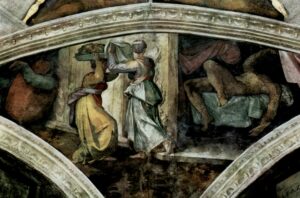
I enjoy art and I was nervous for my session but Oh Boy! I did not expect fifty people. But there I was, in a dark room with a projector and people waiting to listen to me, in rapt silence.
I did not expect the hall to be so full.
Judith slaying Holofernes is a Biblical story painted by multiple artists throughout history. But the ones painted by Caravaggio and Artemisia Gentileschi are my absolute favorite. Caravaggio was an Italian painter of the late 16th and early 17th century. His dramatic play of lighting and realistic observation of physical elements in his paintings influenced Baroque art.


Caravaggio greatly inspired his close friend Orazio Gentileschi and subsequently his daughter Artemisia Gentileschi. Extremely gifted, Artemisia started painting at a young age and would often spend hours in her father’s studio. However, her reputation as an artist has often been overshadowed by the notorious public trial that followed her rape by an associate of her father’s, the painter Agostino Tassi, when she was still a teenager.
She was not only publicly humiliated but tortured on stand to prove her innocence as Tassi sat comfortably during the proceedings, such was the irony of Roman Justice. When one contrasts the two Judiths, Caravaggio’s and Artemisia’s, one is immediately surprised by the stronger and ferocious Artemisia’s Judith. It’s almost as if you are looking at Artemisia slaying Tassi for his heinous crime. It is interestingly a self portrait, widely dubbed as revenge in oil.

It is interesting to note, that all the other Judiths painted before and during that time, have been timid, shy, almost disgusted at the thought of murder and very feminine in their countenance. That’s how women were perceived to be. But here comes a woman, who paints a women and creates a sensation because her woman is eager and has rolled up her sleeves, is beheading a man while her help pushes the man down. In another painting, Artemisia painted the next scene where her Judith is confident and looking out for her maidservant as she keeps the decapitated head in a bag.



The idea that it’s our biases that lead us to perceive situations or people a certain way is very interesting. When we studied the contrast in these paintings, surprisingly people had varied observations. Suddenly, I looked around the room and was pleasantly surprised to see pin drop silence. Drawing parallels with contemporary times and looking at our biases with regard to gender, religion, caste etc was the major takeaway from the session.

 Video KYC
Video KYC

